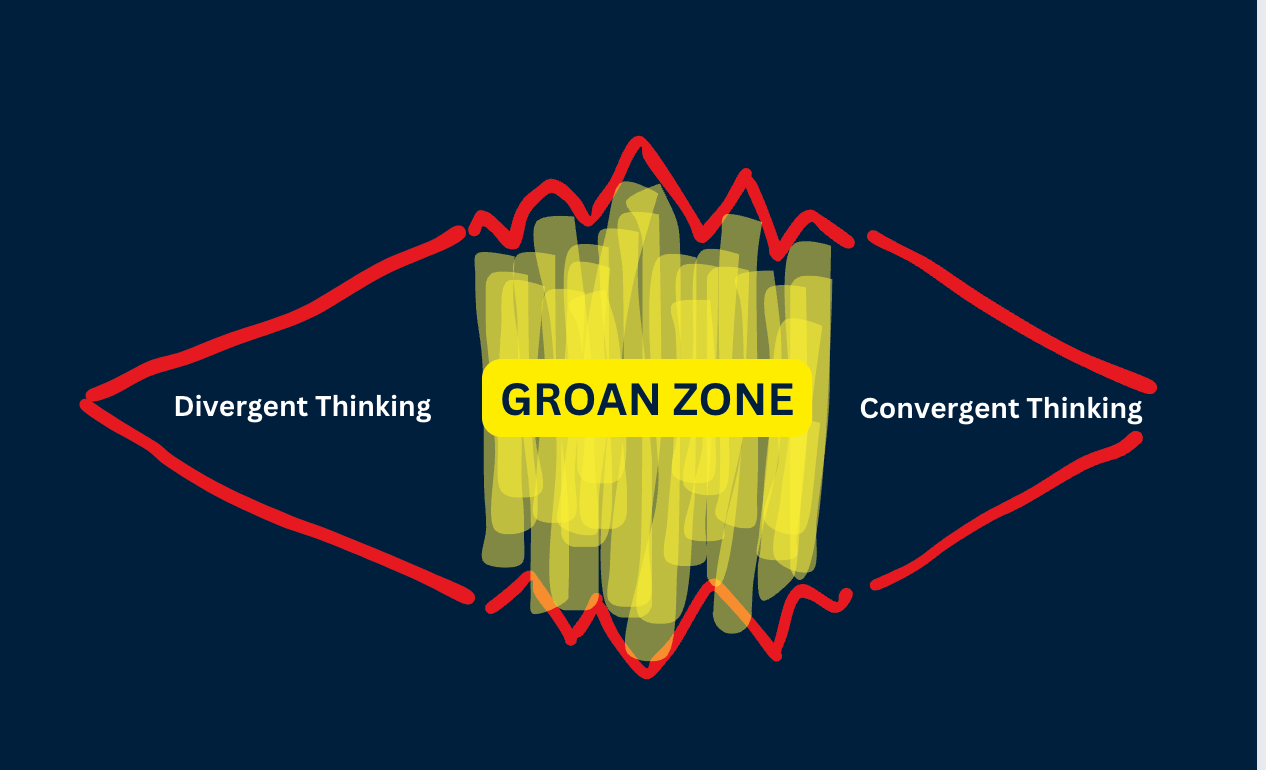Turning Team Frustration into Fuel: The Power of Embracing the "Groan Zone" in workshop facilitation and Design Thinking!
How you can transform the hardest part of facilitation into a source of alignment and growth.
As agile leaders striving to excel in facilitation, one of the most overlooked but essential aspects of group dynamics is the "Groan Zone."
This term, coined to describe the phase of discomfort and misunderstanding in group decision-making, can be a game-changer in facilitating innovative, inclusive, and sustainable solutions.
Embracing the Groan Zone can be transformative, fostering deeper connections, trust, and collaboration that set a foundation for lasting progress and creativity.
Here’s why understanding and navigating the Groan Zone is a skill worth mastering and how it connects to broader practices like Design Thinking.
The Groan Zone: Turning Discomfort into Innovation
In a typical design thinking session (or other workshop session like an agile retrospective), the Groan Zone appears just after diverse viewpoints have been shared. It is the transitional phase that occurs when teams move from the divergent thinking phases (like ideation) to convergent thinking phases (like prototyping).
This stage is usually marked by confusion, frustration, and an eagerness for quick resolution.
But within this discomfort lies enormous potential. When facilitated effectively, this phase becomes the breeding ground for genuine understanding, alignment, and innovative solutions.
Characteristics of the Groan Zone
Confusion: Team members may feel disconnected due to different perspectives and frames of reference.
Frustration: The effort to understand these new viewpoints and integrate them can be challenging.
Impatience: There’s a temptation to skip past the struggle, seeking a rapid consensus instead of diving into the roots of differing opinions.
Why Embracing the Groan Zone Matters
The discomfort of the Groan Zone often makes people want to bypass it. They tend to misinterpret the groan zone as an insurmountable obstacle rather than an integral part of the process.
However, teams that can lean into this stage, acknowledging and exploring differing opinions, often achieve:
Shared Understanding: A unified perspective arises from grappling with diverse ideas, paving the way for collective ownership of solutions.
Inclusive and Sustainable Solutions: Working through diverse views enriches the final outcome, as solutions resonate with the group’s varied needs and goals.
Stronger Team Relationships: Navigating the Groan Zone builds resilience and empathy among team members, resulting in trust that strengthens over time.
Facilitating Through the Groan Zone
Here are a few ways to guide your teams through this phase, transforming discomfort into collaboration and insight:
Acknowledge the Struggle: Encourage team members to view the Groan Zone as a necessary step rather than a problem to sidestep. Emphasize that the discomfort they feel is part of the process and will lead to better results.
Foster Active Listening: Techniques like paraphrasing, clarifying questions, and reflection help bridge communication gaps. These skills are essential for facilitators in building a shared framework of understanding.
Build Empathy with Interpersonal Activities: Activities that strengthen relationships help counterbalance frustration. Exercises that encourage team members to see each other’s perspectives lay the foundation for empathy and trust.
Use Structured Facilitation Techniques: Methods like "Backing Up From Solutions to Needs" help teams move away from conflicting positions and toward identifying shared interests. The method is used in group problem-solving to shift the focus from arguing over proposed solutions to understanding the underlying needs of each individual involved. This shift in focus can illuminate common ground and clarify how best to proceed.
Encourage Patience: The Groan Zone requires time. As a facilitator, support team members by holding space for pauses and silences, creating an environment where everyone feels encouraged to participate openly.
The Groan Zone and Design Thinking: A Perfect Pair
The discomfort of the Groan Zone parallels the exploratory nature of Design Thinking. In Design Thinking, success is rarely linear; it requires continuous iteration, empathy, and a willingness to challenge assumptions.
Just as the Groan Zone necessitates patience and active listening, Design Thinking thrives on these principles:
Human-Centered Solutions: Design Thinking encourages empathy for users and stakeholders. The Groan Zone similarly demands empathy within the team, helping everyone understand diverse needs and co-create solutions that truly resonate.
Collaboration and Innovation: Both Design Thinking and the Groan Zone emphasize the importance of collaborative problem-solving. Integrating viewpoints enhances creativity and moves the group toward innovative solutions.
Iterative Progress: Embracing the iterative nature of both Design Thinking and the Groan Zone allows teams to refine and adapt solutions as they gain deeper insight into the problem at hand.
By mastering the Groan Zone, young agile leaders can guide their teams through periods of misunderstanding to create meaningful, people-centered solutions.
This ability to transform tension into innovation is a hallmark of successful leadership in the agile and design thinking spaces.
Takeaway: Embrace Discomfort, Cultivate Innovation
The Groan Zone is a rite of passage for teams working toward shared understanding and sustainable outcomes. For young agile leaders, the ability to facilitate through this challenging phase can be a powerful advantage in accelerating career growth and becoming a sought-after leader in agile environments.
Leaning into the Groan Zone with empathy, patience, and purpose doesn’t just help the team reach consensus; it fosters a culture of resilience and creativity. When teams learn to value and navigate the Groan Zone, they unlock their collective potential and lay the groundwork for continuous improvement and innovation.
♻️ **If you found value in this article, please share it with others in your network.**
Resources for deep dive
Facilitators Guide to Participative Decision Making, Sam Kaner
Ready to take your agile leadership to the next level?
Join Agile Action Heroes, a growing community of passionate agile enthusiasts just like you. Get access to exclusive resources, expert advice, and peer support that will help you sharpen your skills and lead your teams with confidence. Whether you're looking for guidance, inspiration, or collaboration opportunities, you'll find it here.


